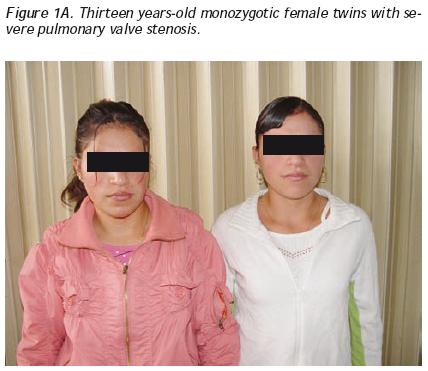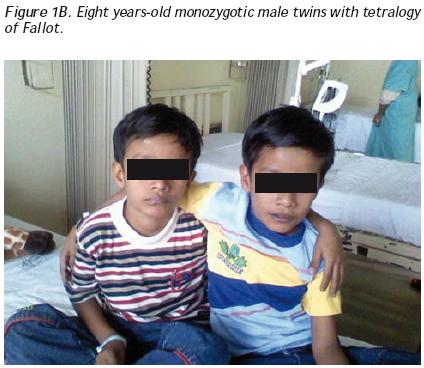Servicios Personalizados
Revista
Articulo
Indicadores
Links relacionados
-
 Similares en
SciELO
Similares en
SciELO
Compartir
Archivos de cardiología de México
versión On-line ISSN 1665-1731versión impresa ISSN 1405-9940
Arch. Cardiol. Méx. vol.80 no.1 Ciudad de México ene./mar. 2010
Comunicaciones breves
Concordance of congenital heart defects in two pairs of monozygotic twins: pulmonary stenosis and tetralogy of Fallot
Concordancia en los defectos cardiacos congénitos, en dos pares de gemelos monocigóticos: estenosis pulmonar y tetralogía de Fallot
Carlos Alva,1 Felipe David Gómez,2 Santiago Jiménez–Arteaga,2 Lucelli Yáñez,2 Lilia Ochoa.3
1 Director of Congenital Heart Disease Department, Hospital, Centro Médico Nacional Siglo XXI
2 Staff Member of Congenital Heart Disease Department, Hospital, Centro Médico Nacional Siglo XXI
3 Fellow in Human Genetics Department, Hospital, Centro Médico Nacional Siglo XXI
Corresponding author:
Carlos Alva.
Congenital Heart Disease Department,
Cardiology Hospital,
Centro Médico Nacional Siglo XXI,
Av.Cuauhtémoc 330, Col. Doctores,
México City CP 06720, México.
Phone: 5255 5585 2443.
E mail: echoca@yahoo.com
Received: December 12, 2008.
Accepted September 23, 2009.
Resumen
Concordancia de defectos cardiacos congénitos en dos pares de gemelos monocigóticos. Se presentan dos pares de gemelos con concordancia específica en sus lesiones cardiacas congénitas.
Se revisaron todos los gemelos monocigóticos con concordancia específica en sus lesiones cardiacas congénitas en los últimos 18 años. Se encontraron dos pares de gemelos. El primer par, dos gemelas monocigóticas de 13 años de edad, en ambas se encontró severa estenosis infundibular y valvular pulmonar. En el segundo par, dos gemelos de 8 años de edad, se diagnosticó en ambos, mediante ecocardiografía, cateterismo cardiaco y angiocardiografía tetralogía de Fallot. La prueba de hibridación por fluorescencia fue, en ambos pares, negativa para microdeleción del cromosoma 22q11. Las diferencias anatómicas entre los gemelos estudiados, no se explican suficientemente sobre bases genéticas exclusivamente; es necesario, considerar la participación de otros factores adquiridos, probablemente durante los primeros estadios del desarrollo embriológico. Estos son los dos primeros casos de gemelos con concordancia específica reportados en México.
Palabras clave: Cardiopatías congénitas en gemelos; Gemelos monocigotos con lesiones congénitas; Concordancia específica entre gemelos; Gemelos monocigóticos; Estenosis valvular pulmonar; Tetralogía de Fallot.
Abstract
Two pairs of twins with specific concordance in congenital heart lesions are presented. We reviewed all the monozygotic twins with specific concordance in congenital heart lesions in the last 18 years. Two pairs were found. First, a pair of 13 years–old monozygotic female twins; a severe infundibular and pulmonary valve stenosis was discovered in both girls. In the second pair of twins (8 years–old boys), Tetralogy of Fallot was diagnosed by echocardiogram, cardiac catheterization and angicardiography. In fluorescence hybridization test in situ all patients were negative for microdeletion in chromosome 22q11. Anatomic differences between twins are not enough explained on genetic bases; it's necessary to consider the role of other factors, probably acquired during the first stages of embryonic development. These are the two first pairs of twins with specific concordance in congenital cardiac lesions reported in Mexico.
Key words: Congenital heart disease in twins; Congenital lesions in twins; Specific concordance in twins; Monozygotic twins; Valvar pulmonary stenosis; Tetralogy of Fallot.
Introduction
Since Price's report in 1950,1 it has been recognized that monozygotic twins provide an opportunity to study genetic contribution in the development of cardiovascular malformations. The incidence of congenital heart defects among singletons is 6/1000 live births, compared to 17.2/1000 in monozygotic twins, while in dizygotic twins the incidence is approximately 8/1000.2 When both twins are affected, concordance is said to occur. Concordance incidence in dizygotic twins is 5%, compared to 25% in monozygotic twins.3 In this paper, two pairs of monozygotic twins with specific concordance of congenital heart defects are reported.
Case report 1
Monozygotic twins with pulmonary stenosis
U.H. and E.H. were13 year–old monozygotic female twins; both girls had cardiac murmurs and were referred to our hospital. They were completely asymptomatic and their phenotypes were very similar (Figure 1A). Both of them had blood type B+; in a fluorescence hybridization test in situ the two girls were negative for chromosome 22q11 microdeletion. Echocardiographic examination showed a severe infundibular and pulmonary valve stenosis in both of them. Systolic gradient measured by Doppler was 140 mmHg in U.H., and 90 mmHg in E.H. During cardiac catheterization, U.H. had right ventricular pressures of 120/8 and 30/10 in the pulmonary artery, and E.H. had 200/14. Echocardiogram and selective angiogram showed severe dysplastic pulmonary valve in the right ventricle of both twins.

In June 2006, the two patients underwent cardiac surgical correction with transannular patch under cardiopulmonary bypass. During surgery, severe pulmonary valve stenosis with hypoplastic annulus was found in both of them. In addition, U.H. presented infundibular stenosis which was removed. The patients recovered uneventfully from operation. Today, six years after the procedure, both patients are asymptomatic with normal development and a control echocardiogram revealed a residual gradient below 20 mmHg and minimal pulmonary insufficiency.
Case report 2
Monozygotic twins with Tetralogy of Fallot
J.T. and N. T. were 8 year–old male monozygotic twins, with almost identical phenotypes (Figure 1B). Both had blood O+; in a fluorescence hybridization test in situ the two boys were negative for microdeletion in chromosome 22q11. In both twins, Tetralogy of Fallot was diagnosed by echocardiogram, cardiac catheterization and angiocardiogram. In the first twin a Blalock–Taussig shunt had been performed. This patient had stress dyspnea and physical examination revealed cyanosis ++. Echocardiogram demonstrated Tetralogy of Fallot with an obstructive 60 mmHg gradient in the right ventricular outflow tract.

Cardiac catheterization confirmed the echocardiogram diagnosis and an additional stenosis was found at the origin of the left pulmonary artery (Figure 2a). The McGoon index was 1.3. In February 2008 surgical correction was performed with transannular patch, pulmonary valve prosthesis, and patches in left main coronary and pulmonary arteries; the ventricular septal defect was closed too. During surgery a laceration of the pulmonary artery with important bleeding occurred as a complication. In the intensive care unit, the patient developed pneumonia due to Sthaphylocococus aureus, with bad and long evolution. It was not possible to disconnect the patient from ventilator. Fifteen days later, this twin died because of septic shock.

In the second twin no previous shunt was done. During physical examination cyanosis ++ it was seen and arterial saturation was 82%. Echocardiography and angiocardiography showed favorable anatomy (Figure 2B). The McGoon index was 2.1. Total surgical correction was performed in January 28, 2008. He recovered uneventfully. Three months later, an echocardiogram revealed a maximum gradient of 22 mmHg and the patient presented no symptoms.

Discussion
Monozygotic twins are less frequent than dizygotic twins and account for approximately a third of total number of twins, but incidence of congenital anomalies in monozygotic twins is about 10%.4
Congenital heart disease concordance in monozygotic twins occurs at a frequency of 25%, which is high when compared to other congenital disorders. However, in previous literature usually it is not specified whether concordance refers to either the presence of the same cardiac defect in both twins, or to some cardiac malformation present in the two. We will refer to specific concordance in the former concept.
There are very few reports on specific concordance of congenital cardiac malformations. After detailed search of the literature (PubMed/Medline) only three reports of twins with tetralogy of Fallot were found. In one of the reports, both twins had pulmonary atresia and the same intracardiac defects, with anatomic differences in large vessels. Both patients were positive for microdeletion in chromosome 22q11.5 In France, a pair of twins had the same disorder, but they were negative for microdeletion in chromosome 22q11 (as in both of our cases); it was reported by Laugel et al in 2001 V.6 The first monozygotic pair of twins with Tetralogy of Fallot in India was reported by Patel AB et al in 2002.7 In these works, authors concluded that the differences found could not be explained on genetic grounds and suggested the influence of other factors in the developing embryo.
There are two other reports of specific concordance. In the first, the presence of persistent truncus arteriosus in both monozygotic twins, without DiGeorge phenotype syndrome and no deletion in chromosome 22q11 is described.8 The second report presents a successfully operated pair of twins with ventricular septal defect.9 This work, in which we have studied two pairs of identical twins, one with pulmonary valve stenosis and the other with Tetralogy of Fallot, adds to the few published cases of specific concordance. Just like in the previous reports, both twins had the same disorder, with minor differences, particularly in the severity of the lesion. In agreement with other authors, these differences could be explained by the influence of other factors probably acquired during the first stages of embryonic development.
Acknowledgements
Authors are thankful to Hector Alva PhD for his help in the preparation of the English manuscript.
References
1. Price B. Primary biases in twins studies. Am J Human Genet 1950,2:293–35. [ Links ]
2. Burn J. The aetiology of congenital heart disease. In: Anderson RH, Baker EJ, Macartney FJ, Rigby ML, Shinebourne EA, Tynan M (eds) Paediatric Cardiology 2002. London. Curchill Livingstone 2002, p157. [ Links ]
3. Stark AR Twins. In: Cloherty J, Stark AR, Eichenwald EC. Manual of Neonatal Care 2004. Philadelphia, Lippincott Williams and Wilkins, 141–145. [ Links ]
4. Hall JG. Twinning. Developmental biology IV. Lancet 2003;362:735–743. [ Links ]
5. Lu JH, Chung MY, Hwang B, et al. Monozigotic twins with chromosome 22q11 microdeletion and discordant phenotypes in cardiovascular pattering. Pediatr Cardiol 2001;22:260–263. [ Links ]
6. Laugel V, Livolsi A, Viville B, et al. Tetralogy of Fallot in monozygotic twins. Arch Pediatr 2001;8:385–388 [ Links ]
7. Patel AB, Renge RL. Tetralogy of Fallot in monozygotic twins. Indian Heart J 2002;54:83–85. [ Links ]
8. Mas C, Delatycki MB, Weintraub RG. Persistent truncus arteriosus in monozygotic twins: Case report and literature review. Am J Med Genet 1999;82:146–148. [ Links ]
9. Kobayashi M, Ishikawa S, Ohtaki A, et al. Ventricular septal defect associated with pulmonary hypertension in monozygotic twins a case report with surgical repair. Jpn J Thorac Cardiovasc Surg 1998;46:1152–1155. [ Links ]














